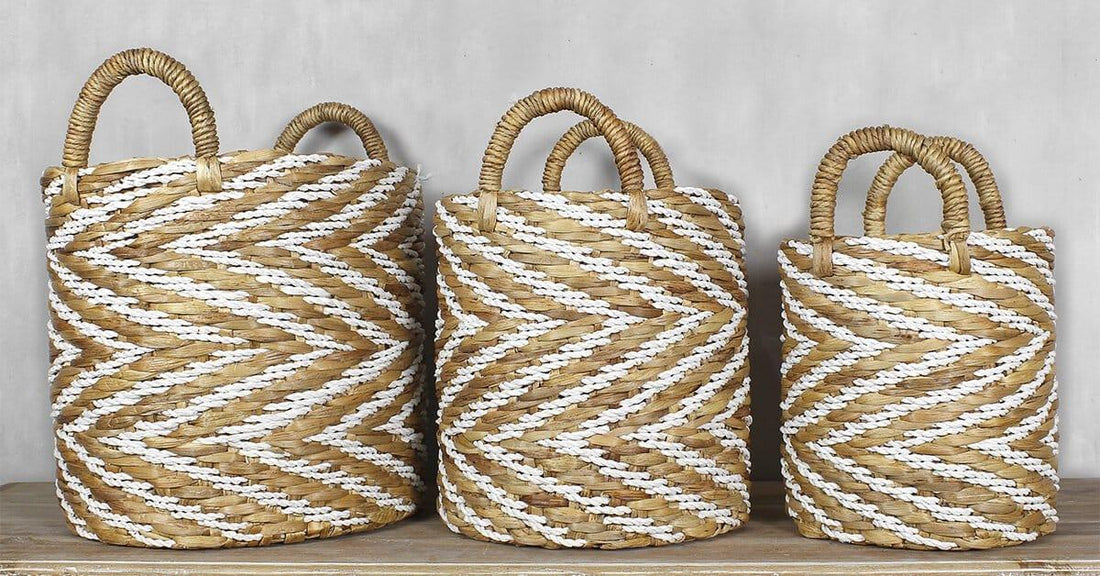Handwoven Baskets
From the tiniest fiber strands to the twist to form exquisite designs, handweaving baskets - among other household items, have been traced back to at least 12,000 years ago, if not much longer. The East Asians (China and Japan), followed by Native Americans, were the masters of handweaving baskets and other household items. In their ancient civilizations, handwoven baskets were then utilized for a variety of domestic activities, including fishing, food collection, funeral, religious purposes, and even carrying babies during travel.
Kulture Deco’s signature Macrame basket
Made of hyacinth fiber and cotton
Years later, they still play an integral role in religious events in some cultures, such as the Balinese, where people use coconut leaf-woven trays and baskets to place offerings to the gods. Interestingly, during WWI and WWII, the army dropped food and supplies to the troops wrapped in handwoven baskets from army planes! Isn't that incredible?
Handwoven baskets in the contemporary world
Handwoven baskets are now used for home decorations, home interior furnishing, laundry baskets, bag-lined waste bins, and other light jobs in the modern world. We aren't giving these baskets enough credit, given their lengthy and tenacious history! In contrast to the tremendous change, the materials used to weave most baskets have not changed significantly. Natural materials such as rattan, willow barks, grass, bamboo, vines, and strong tree branches such as oaks are still used to hand-weave baskets. The main distinction here is first, the time, and then the visual aspects of these baskets. Intricate designs, brilliant colors, and more flexible fibers are used in baskets manufactured solely for household adornment. Meanwhile, baskets optimized for functionality, such as collecting food or carrying heavy items, are typically made with firmer cords and thicker fibers to ensure longevity.
Handweaving techniques and the right materials
Basket weaving is a true art form. Every braided vessel is the result of a marathon of holistic processes that begin with the selection of a natural resource and continue with the processing and twisting of these fibers into exquisite home décor pieces. Every zig-zag, checker, coil, and stripe is a monument to the art; an infusion of such classic craft into the modern world.
A set of three: Zig-zag baskets
Handwoven by a North Balinese craftsman.
The elasticity of the basketry material is crucial. Brittle stems will not be able to smoothly twist into tight coils and squeeze through tight places. It is also worth noting that tougher fibers will be employed to make the frame, or ribs, of these handwoven baskets. Every material used in handweaving must go through a procedure that includes splitting stalks, diving soft and hard sections of the vine, and drying the remaining fibers. Some fabrics will require a second round of rehydration to make weaving easier.
The art of basketry comes in four different methods, for instance, coiling, plaiting, twining, and wicker. They all start with the basic process of weaving fiber strands over and under one another to create the required design. Loops, twining, ribs, and spokes are all used in handweaving baskets, with the last being more difficult to master than the others.
The handle of Macrame basket
Made of hyacinth fiber and cotton
A wicker-patterned basket, for example, starts with a simple coil, which is made by weaving a thicker piece of the stem into a basic coil, then weaving smaller and more flexible ones around it. Handweaving a wicker basket begins with the creation of spokes, which are a series of supporting frameworks in the shape of stakes, and continues with weaving under and over the spokes all the way around the basket. When it comes to the basket's handles, it's normal practice to lash the rim and wrap the handle to give it a more polished appearance.
What are other handweaving facts do you know? Comment in the section below, the Kulture Deco team is excited to discover your knowledge!






